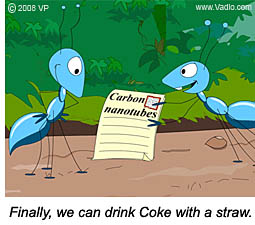
Illustrated by: Dr. Biology
You may not think about it, but size does matter. It is especially true when talking about the very tiny things that exist in the nano world. Things in this tiny and often violent place no longer play by the same rules as the things we can see. They don’t even behave the same as things we can see with a light microscope.

Unlike what the ants in our cartoon might believe, if you could shrink down to the size of a nano object and take a look around you would see that it is was very different than the world we see. In the nano world things like to move around. Often objects crash into each other. If you could be a spectator of this tiny world you might think you were watching a magic show because you would be uncertain if you were actually seeing anything.
How Small Is a Nanoparticle?
Even if we could drink Coke through a nanotube would it be too small for our ant cartoon characters to use? After all we are talking about things that are a billion times smaller than a meter. Since we cannot see things this small even with most microscopes it is hard to understand how really tiny nano objects can be.
To get an idea of what the nano scale is like, here is an activity talked about during the beginning of the Ask A Biologist podcast called “Tiny Matter." You will see the difference in scale even before they change a billion times in size. The two sections take you through the exercise of magnifying a simple one inch line. At first we find out what happens if the line was a 100,000 times larger. This is just a warm up for magnifying the line a billion times!
"Life in Research" cartoon used with permission of Valdo.com.
Read more about: Nanoparticles - A Matter of Scale
Bibliographic details:
- Article: Nanoparticles - A Matter of Scale
- Author(s): CJ Kazilek
- Publisher: Arizona State University School of Life Sciences Ask A Biologist
- Site name: ASU - Ask A Biologist
- Date published:
- Date accessed:
- Link: https://askabiologist.asu.edu/explore/matter-scale
APA Style
CJ Kazilek. (). Nanoparticles - A Matter of Scale. ASU - Ask A Biologist. Retrieved from https://askabiologist.asu.edu/explore/matter-scale
Chicago Manual of Style
CJ Kazilek. "Nanoparticles - A Matter of Scale". ASU - Ask A Biologist. . https://askabiologist.asu.edu/explore/matter-scale
CJ Kazilek. "Nanoparticles - A Matter of Scale". ASU - Ask A Biologist. . ASU - Ask A Biologist, Web. https://askabiologist.asu.edu/explore/matter-scale
MLA 2017 Style

Illustration of DNA passing out of a carbon nanotube (by Hao Liu).
Be Part of
Ask A Biologist
By volunteering, or simply sending us feedback on the site. Scientists, teachers, writers, illustrators, and translators are all important to the program. If you are interested in helping with the website we have a Volunteers page to get the process started.

